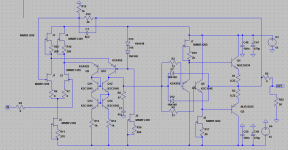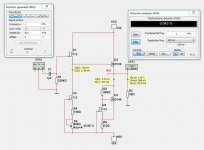> But the THD distortion is not nice - THD 0.287% is not acceptable.
I got 0.03% THD at 0.92V pk on 32R with 120mA bias.
Cheers,
Patrick
I got 0.03% THD at 0.92V pk on 32R with 120mA bias.
Cheers,
Patrick
At that higher idle current, I get 0.04% with matchbook math.
It's mostly about the gain (NFB) and the current swing (as fraction of idle current).
It's mostly about the gain (NFB) and the current swing (as fraction of idle current).
Low-impedance (under 50 ohm) headphones will play well at home with your receiver and on-the-go with your smart phone, and that's why the vast majority of in-, on-, and over-the-ear headphones are low-impedance designs. High-impedance models are much better suited to home than on-the-go use. Sennheiser and Beyerdynamic are two companies that offer high-impedance consumer headphones with up to 600 ohm-rated designs.
Audioreputation.com
Audioreputation.com
I did this one, but I did not have time to test it in reality ...
https://ctrlv.cz/shots/2018/08/07/ETvB.png
https://ctrlv.cz/shots/2018/08/07/FGck.png
PCB 5x5cm:
https://ctrlv.cz/shots/2018/08/07/lTxw.png
https://ctrlv.cz/shots/2018/08/07/cPej.png
https://ctrlv.cz/shots/2018/08/07/MZqW.png
THD=0.002%/20k (250mW/32R)
IMD:
https://ctrlv.cz/shots/2018/08/07/Ase2.png
0.06%/19k+20k (50mW/32R)
OLG:
https://ctrlv.cz/shots/2018/08/07/4iVr.png
https://ctrlv.cz/shots/2018/08/07/ETvB.png
https://ctrlv.cz/shots/2018/08/07/FGck.png
PCB 5x5cm:
https://ctrlv.cz/shots/2018/08/07/lTxw.png
https://ctrlv.cz/shots/2018/08/07/cPej.png
https://ctrlv.cz/shots/2018/08/07/MZqW.png
THD=0.002%/20k (250mW/32R)
IMD:
https://ctrlv.cz/shots/2018/08/07/Ase2.png
0.06%/19k+20k (50mW/32R)
OLG:
https://ctrlv.cz/shots/2018/08/07/4iVr.png
Attachments
It's a Scott Wurcer Phono without RIAA but with NFB. 🙂
A simplified universal differential or single ended phono preamp
Patrick
A simplified universal differential or single ended phono preamp
Patrick
In practice if you want to have perfect thermal tracking (no DC drift), it is better to make top and bottom identical.
https://www.diyaudio.com/community/threads/mosfet-follower-headphone-amplifier.95841/post-1130743
My own experience is that CFP measures well, but sound a bit too bright.
I only use them for portables with very low bias.
Cheers
Patrick
https://www.diyaudio.com/community/threads/mosfet-follower-headphone-amplifier.95841/post-1130743
My own experience is that CFP measures well, but sound a bit too bright.
I only use them for portables with very low bias.
Cheers
Patrick
Thanks for your comment. I visited your link. To use LU1014 is an elegant solution. To use MOSFETs for cascode also benefit.In practice if you want to have perfect thermal tracking (no DC drift), it is better to make top and bottom identical.
https://www.diyaudio.com/community/threads/mosfet-follower-headphone-amplifier.95841/post-1130743
My own experience is that CFP measures well, but sound a bit too bright.
I only use them for portables with very low bias.
Cheers
Patrick
I have not built my circuit, so I can not tell about sound.
I take your word for that upper and lower should be the same.
Anyway I will post an upgrade with J113 transistors. With lower THD as well.
Headphone Buffer Amplifier upgrade Revision 2.
With J113 FETs.
Devices
3 x J113 FET
1 x BD139
1 x BD140
Power Supply
2x12VAC Transformer
Regulators LM7812/LM7912 or LM317T/LM337T
Adjustments
Adjust potentiometer for zero offset on the output.
Replace R6 if necessary for ~100mA in output stage.
As can be seen the THD is lower than my first version.
Like THD 0.045 is acceptable for a circuit without global feedback. Ask Nelson Pass!
With J113 FETs.
Devices
3 x J113 FET
1 x BD139
1 x BD140
Power Supply
2x12VAC Transformer
Regulators LM7812/LM7912 or LM317T/LM337T
Adjustments
Adjust potentiometer for zero offset on the output.
Replace R6 if necessary for ~100mA in output stage.
As can be seen the THD is lower than my first version.
Like THD 0.045 is acceptable for a circuit without global feedback. Ask Nelson Pass!
Attachments
- Home
- Amplifiers
- Headphone Systems
- Headphone Buffer Amplifier


